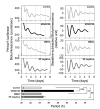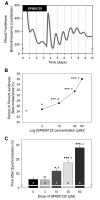c-Jun N-terminal kinase inhibitor SP600125 modulates the period of mammalian circadian rhythms
- PMID: 17270352
- PMCID: PMC2238338
- DOI: 10.1016/j.neuroscience.2006.12.037
c-Jun N-terminal kinase inhibitor SP600125 modulates the period of mammalian circadian rhythms
Abstract
Circadian rhythms are endogenous cycles with periods close to, but not exactly equal to, 24 h. In mammals, circadian rhythms are generated in the suprachiasmatic nucleus (SCN) of the hypothalamus as well as several peripheral cell types, such as fibroblasts. Protein kinases are key regulators of the circadian molecular machinery. We investigated the role of the c-Jun N-terminal kinases (JNK), which belong to the mitogen-activated protein kinases family, in the regulation of circadian rhythms. In rat-1 fibroblasts, the p46 kDa, but not the p54 kDa, isoforms of JNK expressed circadian rhythms in phosphorylation. The JNK-inhibitor SP600125 dose-dependently extended the period of Period1-luciferase rhythms in rat-1 fibroblasts from 24.23+/-0.17-31.48+/-0.07 h. This treatment also dose-dependently delayed the onset of the bioluminescence rhythms. The effects of SP600125 on explant cultures from Period1-luciferase transgenic mice and Period2(Luciferase) knockin mice appeared tissue-specific. SP600125 lengthened the period in SCN, pineal gland, and lung explants in Period1-luciferase and Period2(Luciferase) mice. However, in the kidneys circadian rhythms were abolished in Period1-luciferase, while circadian rhythms were not affected by SP600125 treatment in Period2(Luciferase) mice. Valproic acid, already known to affect period length, enhanced JNK phosphorylation and, as predicted, shortened the period of the Period1-bioluminescence rhythms in rat-1 fibroblasts. In conclusion, our results showed that SP600125 treatment, as well as valproic acid, alters JNK phosphorylation levels, and modulates the period length in various tissues. We conclude that JNK phosphorylation levels may help to set the period length of mammalian circadian rhythms.
Figures







Similar articles
-
Selective serotonin reuptake inhibitors and raft inhibitors shorten the period of Period1-driven circadian bioluminescence rhythms in rat-1 fibroblasts.Life Sci. 2008 Jun 6;82(23-24):1169-74. doi: 10.1016/j.lfs.2008.03.024. Epub 2008 Apr 16. Life Sci. 2008. PMID: 18482738 Free PMC article.
-
Regulation of cAMP-induced arylalkylamine N-acetyltransferase, Period1, and MKP-1 gene expression by mitogen-activated protein kinases in the rat pineal gland.Brain Res Mol Brain Res. 2005 Oct 3;139(2):333-40. doi: 10.1016/j.molbrainres.2005.06.004. Brain Res Mol Brain Res. 2005. PMID: 16024134
-
Heme reversibly damps PERIOD2 rhythms in mouse suprachiasmatic nucleus explants.Neuroscience. 2009 Dec 1;164(2):832-41. doi: 10.1016/j.neuroscience.2009.08.022. Epub 2009 Aug 19. Neuroscience. 2009. PMID: 19698763 Free PMC article.
-
Melatonin, the pineal gland, and circadian rhythms.J Biol Rhythms. 1993;8 Suppl:S73-81. J Biol Rhythms. 1993. PMID: 8274765 Review.
-
Physiology and regulation of biological rhythms in laboratory animals: an overview.Lab Anim. 1989 Apr;23(2):107-25. doi: 10.1258/002367789780863538. Lab Anim. 1989. PMID: 2651797 Review.
Cited by
-
Circadian Rhythm Disturbances in Mood Disorders: Insights into the Role of the Suprachiasmatic Nucleus.Neural Plast. 2017;2017:1504507. doi: 10.1155/2017/1504507. Epub 2017 Nov 5. Neural Plast. 2017. PMID: 29230328 Free PMC article. Review.
-
Diverse roles for MAPK signaling in circadian clocks.Adv Genet. 2013;84:1-39. doi: 10.1016/B978-0-12-407703-4.00001-3. Adv Genet. 2013. PMID: 24262095 Free PMC article. Review.
-
Epigenetic inheritance of circadian period in clonal cells.Elife. 2020 May 27;9:e54186. doi: 10.7554/eLife.54186. Elife. 2020. PMID: 32459177 Free PMC article.
-
Cell-based inhibitor screening identifies multiple protein kinases important for circadian clock oscillations.Commun Integr Biol. 2015 Jul 25;8(4):e982405. doi: 10.4161/19420889.2014.982405. eCollection 2015 Jul-Aug. Commun Integr Biol. 2015. PMID: 26478783 Free PMC article.
-
Inhibitors of c-Jun N-terminal kinases: JuNK no more?Biochim Biophys Acta. 2008 Jan;1784(1):76-93. doi: 10.1016/j.bbapap.2007.09.013. Epub 2007 Oct 11. Biochim Biophys Acta. 2008. PMID: 17964301 Free PMC article. Review.
References
-
- Akten B, Jauch E, Genova GK, Kim EY, Edery I, Raabe T, Jackson FR. A role for CK2 in the Drosophila circadian oscillator. Nat Neurosci. 2003;6:251–257. - PubMed
-
- Barr RK, Bogoyevitch MA. The c-Jun N-terminal protein kinase family of mitogen-activated protein kinases (JNK MAPKs) Int J Biochem Cell Biol. 2001;33:1047–1063. - PubMed
Publication types
MeSH terms
Substances
Grants and funding
LinkOut - more resources
Full Text Sources
Research Materials
Miscellaneous

